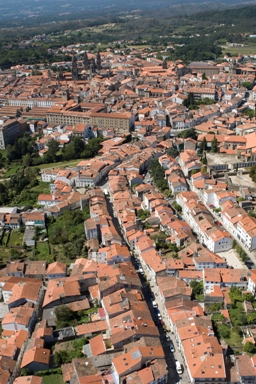LAST SECTION OF THE ROAD FROM SANTIAGO
The Camino enters the municipality of Santiago at Lavacolla. Stepping on a wide, dirt road, the pilgrim borders the airport and crosses the old road, today without traffic. Following the yellow arrows we soon arrive at San Paio, a village with good stone buildings and a simple but pretty church in excellent condition. About 15 minutes later you reach the town of Lavacolla, where its music box, its transept and its temple attract attention. Traditionally it was here where pilgrims prepared and cleaned themselves before entering the city.
In Lavacolla you cross the road that goes from Santiago to the airport. A wooden fence indicates the Camino, which along a narrow path will climb with a not inconsiderable slope and then begin the long descent that will lead to the chapel of San Marcos and Monte do Gozo. We continue descending towards the historic center of the city. The Porta Itineris welcomes pilgrims, a monument from 2004, 17 meters high and made of granite and bronze.
A few meters away you can recognize the old houses of the old neighborhood of S. Lázaro, where since the 12th century there was a large pilgrim hospital dedicated to caring for men sick with leprosy. From here the path always runs along the left side of the road to enter the Os Concheiros neighborhood, along the street that is still called Camiño Francés.
Os Concheiros refers to one of the most powerful medieval guilds in Santiago, which included those artisans who were authorized to make the famous scallops. The Camino now enters the old town at the top of Rúa de S. Pedro, leaving on its left the Church of San Pedro de Fóra and on the right the San Domingos de Bonaval, formerly outside the walls. At the Porta do Camiño, which marks the medieval limit of the walls of Compostela, we now enter the heart of the old city, on the same stones that pilgrims have been stepping on for centuries.
We enter the historic center through Rúa das Casas Reais, known as the Catholic Monarchs promoted the construction of buildings for their government headquarters there. We can stop to visit the Church of Santa María do Camiño, or continue on our way. To the left is the great Pazo de Luaces, which preserves elements from the 15th century such as the portal; On the right, the Iglesia de las Ánimas, where, if we want to follow the pilgrim tradition, we will have to pray 6 Our Fathers in order to save the soul of a loved one. AArrived at the Plaza de Cervantes, one of the most important in the city, we headed to the Acibechía, the door through which they accessed the temple and where one of the most beautiful sources of the city, that of Paradise, was located according to It is narrated in the Calixtino Codex. The fountain no longer exists today, nor do pilgrims enter to see the Apostle through this door, but rather they head through the tunnel of the Pazo de Xelmírez to the Plaza del Obradoiro in search of the grandeur of the baroque façade and the Portico of Glory.


